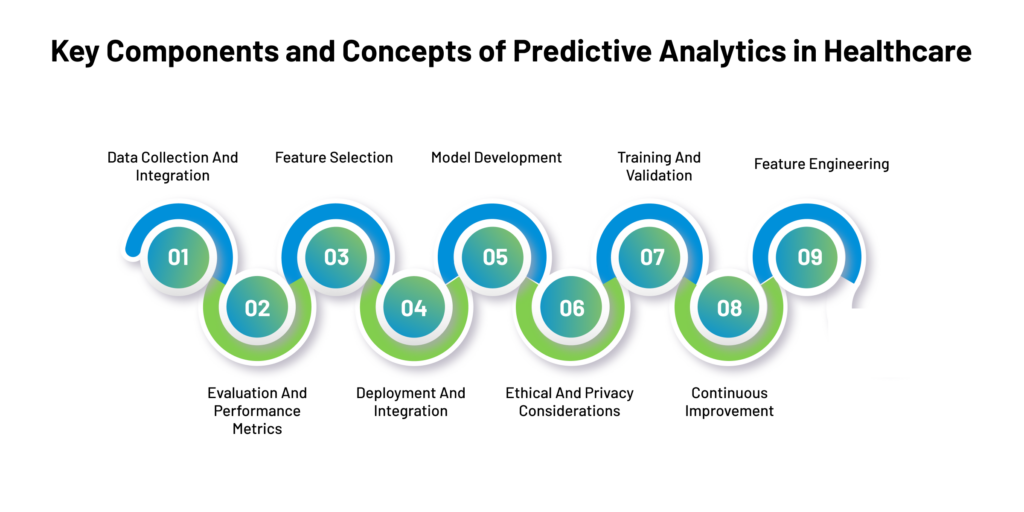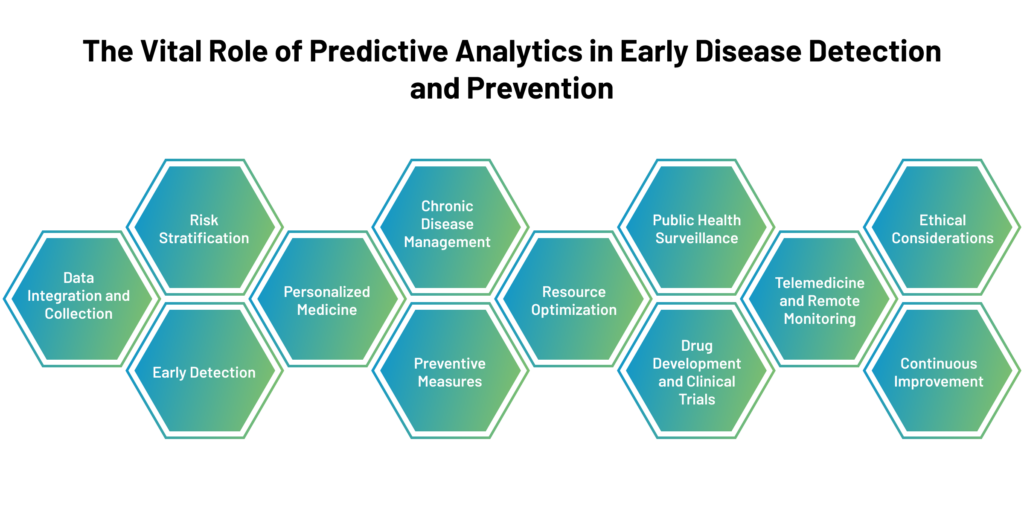In today’s rapidly evolving world, technology is revolutionizing various aspects of our lives, including healthcare. One remarkable area of advancement is predictive analytics, which is quietly but significantly shaping how we approach our well-being. By harnessing data, predictive analytics enables us to foresee potential health issues before they become significant problems.
Think of it as a proactive digital health assistant. It scrutinizes your health data—habits, medical history, and genetic factors—to identify subtle patterns and indicators. What makes this truly remarkable is its capacity to leverage these insights, providing an early heads-up about possible health concerns.
In practice, this means predicting the likelihood of conditions such as diabetes, heart disease, or certain cancers. Rather than waiting for symptoms to arise, healthcare providers can intervene early, offering personalized strategies to prevent or alleviate these issues.
In this blog, we’ll journey into predictive analytics and its vital role in spotting diseases early. We’ll walk through what predictive analytics means, why catching diseases in their infancy is such a big deal, and how this technology is transforming healthcare as we know it. So, get ready to explore how crunching numbers can lead to a healthier future for all of us.
Also, Read – The Influence of Artificial Intelligence in Healthcare
Predictive Analytics in Healthcare: An Overview
Predictive analytics is a branch of data analysis using historical data and statistical algorithms to predict future events or outcomes. In healthcare, predictive analytics refers to applying these techniques to medical data to identify patterns, trends, and potential effects. By analyzing vast amounts of medical information, predictive analytics can assist healthcare professionals in making informed decisions, improving patient care, and enhancing operational efficiency within healthcare systems.
Predictive analytics in healthcare revolves around leveraging data from various sources, such as electronic health records (EHRs), medical imaging, patient demographics, clinical notes, and more, to create models that can predict future health-related events. These events can range from disease diagnoses and treatment outcomes to hospital readmissions and patient deterioration. The primary objective is to provide timely insights to healthcare providers, enabling them to intervene proactively and deliver personalized care that is both effective and efficient.
Essential Components and Concepts of Predictive Analytics in Healthcare

Data Collection and Integration
Healthcare organizations collect a wealth of data from different sources, often fragmented and dispersed. Effective predictive analytics requires integrating diverse data types into a single, accessible repository. This may involve structuring and cleaning the data to ensure its accuracy and consistency.
Feature Selection
In predictive modeling, features are the variables or attributes used to make predictions. Healthcare datasets can be massive, containing numerous variables. Feature selection involves identifying the most relevant and informative variables for the specific prediction task, as using irrelevant or redundant features can lead to overfitting or decreased model performance.
Model Development
Predictive models are constructed using statistical and machine learning algorithms. Standard algorithms include decision trees, logistic regression, random forests, support vector machines, and neural networks. The algorithm choice depends on the data’s nature and the prediction task.
Training and Validation
Models are trained on historical data, including input features and known outcomes. This training process involves adjusting the model’s parameters to minimize the difference between predicted and actual outcomes. Validation is critical to ensure the model’s performance is not over-optimized for the training data (overfitting) and can generalize well to new, unseen data.
Feature Engineering
This involves creating new features derived from existing data to enhance predictive power. For example, combining patient age with specific lab test results might yield more accurate predictions.
Evaluation and Performance Metrics
The accuracy and effectiveness of predictive models are assessed using various metrics, such as accuracy, precision, recall, F1 score, area under the curve (AUC), and others. The choice of metrics depends on the specific healthcare application and the importance of different types of errors.
Deployment and Integration
Once a predictive model is developed and validated, it must be integrated into the healthcare workflow. This could involve incorporating it into electronic health record systems, clinical decision support tools, or even wearable devices for real-time monitoring.
Ethical and Privacy Considerations
Healthcare data is sensitive and subject to privacy regulations (like HIPAA in the United States). Ensuring patient data privacy and complying with legal requirements are crucial to implementing predictive analytics in healthcare.
Continuous Improvement
Predictive models should be regularly updated and improved as new data becomes available. This process helps the model adapt to changing patient populations, medical practices, and technologies.
In healthcare, predictive analytics holds significant potential. It can help identify high-risk patients, optimize treatment plans, reduce hospital readmissions, improve resource allocation, and enhance patient outcomes. However, it’s important to note that while predictive analytics can provide valuable insights, clinical expertise is still essential for interpreting and acting on those insights.
Also, Read – Predictive Analytics for Inventory Optimization and Demand Planning in Logistics
Techniques and Methodologies Used in Predictive Analytics
Predictive analytics is a branch of advanced analytics that utilizes various techniques and methodologies to analyze historical data and predict future events or outcomes. This field is widely used across industries to optimize decision-making, improve efficiency, and gain insights into possible future scenarios. The techniques and methodologies used in predictive analytics can be categorized into several key areas:
Data Collection and Preparation
- Data Gathering: Collecting relevant data from various sources, such as databases, spreadsheets, sensors, and external APIs.
- Data Cleaning: Identifying and correcting errors, inconsistencies, and missing values in the dataset to ensure accuracy and reliability.
- Data Transformation: Converting and restructuring data into a suitable format for analysis, which may involve normalization, aggregation, and feature engineering.
Exploratory Data Analysis (EDA)
- Descriptive Statistics: Summarizing and visualizing the dataset using measures like mean, median, standard deviation, histograms, and scatter plots to understand data distributions and relationships.
- Correlation Analysis: Identifying correlations between variables to understand potential dependencies and patterns.
Feature Selection and Engineering
- Feature Selection: Choosing the most relevant variables (features) for the predictive model to reduce dimensionality and improve model performance.
- Feature Engineering: Creating new features derived from existing ones to capture hidden patterns and relationships that might improve the model’s accuracy.
Model Selection
- Algorithm Selection: Choosing appropriate predictive modeling algorithms based on the nature of the problem, the available data, and the desired level of accuracy. Standard algorithms include linear regression, decision trees, random forests, support vector machines, neural networks, and more.
- Ensemble Methods: Combining multiple models to improve prediction accuracy, such as bagging, boosting, and stacking.
Training and Validation
- Training Data: Splitting the dataset into training and validation sets to train the model on one subset and evaluate its performance on another.
- Cross-Validation: Performing techniques like k-fold cross-validation to assess model generalization and prevent overfitting.
- Hyperparameter Tuning: Adjusting model parameters to find the best configuration for optimal performance.
Model Evaluation
- Metrics: To measure model performance, use appropriate evaluation metrics like accuracy, precision, recall, F1-score, and area under the receiver operating characteristic curve (AUC-ROC).
- Confusion Matrix: Visualizing the true positive, true negative, false positive, and false negative results to assess model behavior.
Deployment and Monitoring
- Model Deployment: Implementing the trained predictive model in real-world scenarios to make ongoing predictions.
- Monitoring and Maintenance: Continuously monitor model performance and retrain as needed to ensure accuracy as new data becomes available.
Time Series Analysis (if applicable)
- Smoothing Techniques: Applying moving averages, exponential smoothing, and other methods to identify trends, seasonality, and cyclic patterns in time series data.
- ARIMA Models: Using AutoRegressive Integrated Moving Average models to forecast future values based on historical data.
Text and Sentiment Analysis (if applicable)
- Natural Language Processing (NLP): Applying NLP techniques to analyze text data, extract features, and predict sentiments or categorize text into meaningful categories.
Advanced Techniques
- Deep Learning: Utilizing deep neural networks for complex pattern recognition tasks, especially when dealing with unstructured data like images, audio, and text.
- Anomaly Detection: Identifying unusual or outlier events in data that could indicate fraud, defects, or other exceptional situations.
Predictive analytics is a multi-faceted discipline encompassing data preparation, exploration, model selection, training, validation, evaluation, deployment, and ongoing monitoring. The specific problem domain, the nature of available data, and the desired outcomes drive the selection of techniques and methodologies. By effectively leveraging these techniques, organizations can unlock valuable insights from their data, make informed decisions, and more accurately anticipate future trends and events.
Also, Read – How to Build an App To Enhance Emergency Healthcare Services
The Vital Role of Predictive Analytics in Early Disease Detection and Prevention
Predictive analytics in early disease detection and prevention is instrumental in revolutionizing healthcare by harnessing data to identify potential health risks, diagnose conditions at earlier stages, and implement proactive measures to prevent diseases from progressing. This approach promises to improve patient outcomes, reduce healthcare costs, and enhance public health. Here’s an elaborate overview of its significance:

Data Integration and Collection
Predictive analytics relies on gathering diverse datasets, including electronic health records (EHRs), medical imaging, wearable devices, genetic information, lifestyle data, and social determinants of health. Integrating these sources provides a comprehensive view of a patient’s health profile.
Risk Stratification
By analyzing historical health data and risk factors, predictive models can stratify populations based on their likelihood of developing certain diseases. This enables healthcare providers to allocate resources more effectively and prioritize high-risk individuals for interventions.
Early Detection
Predictive analytics models can identify subtle changes in patient data patterns that might indicate the early stages of a disease. Detecting diseases earlier enhances the chances of successful treatment and management.
Personalized Medicine
Predictive analytics helps tailor treatments to individual patient’s characteristics, ensuring more accurate and effective interventions. Genetic data and molecular profiling contribute to personalized treatment plans that target the specific genetic makeup of patients.
Chronic Disease Management
Predictive models can monitor chronic conditions in real-time, alerting healthcare providers to patient health status fluctuations. This proactive approach helps prevent disease exacerbations and reduces hospitalizations.
Preventive Measures
Predictive analytics enables healthcare professionals to identify lifestyle factors and behaviors contributing to disease development. Patients can be educated about healthier choices, leading to disease prevention through improved lifestyle habits.
Resource Optimization
By predicting disease outbreaks and trends, healthcare facilities can allocate resources efficiently. For instance, hospitals can prepare for an influx of patients during flu season and ensure sufficient staff and supplies are available.
Public Health Surveillance
Predictive analytics supports public health agencies in monitoring and responding to disease outbreaks. Real-time data analysis helps identify potential epidemics and facilitates swift interventions to prevent their spread.
Drug Development and Clinical Trials
Predictive analytics aids in identifying potential drug candidates and predicting their efficacy in clinical trials. This accelerates the drug discovery process and reduces costs.
Telemedicine and Remote Monitoring
Predictive models integrated with telemedicine platforms can remotely monitor patients’ health conditions and intervene when deviations from expected patterns occur. This is especially valuable for individuals with chronic illnesses.
Ethical Considerations
As with any use of patient data, ethical considerations must be paramount. Ensuring patient consent, data security, privacy, and transparency are crucial to maintaining trust in predictive analytics applications.
Continuous Improvement
Predictive models can learn from new data, refining their accuracy over time. This adaptability is vital for maintaining the effectiveness of early detection and prevention strategies.
In the End!
Embracing the transformative potential of predictive analytics as one of the healthcare software solutions opens the door to a new era of early disease detection and prevention. Through a comprehensive analysis of diverse data streams, healthcare providers gain the ability to swiftly identify potential risks, enabling personalized and timely interventions for each patient. Collaborating with a digital transformation consultant amplifies this power, ensuring a seamless integration of predictive analytics into your healthcare framework.
The significance of this approach extends beyond individualized treatment plans. It redefines the healthcare landscape, shifting the paradigm from reactive problem-solving to proactive risk mitigation. Anticipating and mitigating potential health concerns at their inception becomes the cornerstone of this strategic evolution, underscoring a healthcare system focused on holistic well-being rather than mere recovery.
In the grand scheme, predictive analytics stands not only as a tool but as a pivotal game-changer, propelling healthcare into a realm of intelligent foresight and preventative action. Partnering with a renowned digital transformation services company accentuates this shift, helping your healthcare ecosystem leverage innovation that promises enduring health improvements for all.




